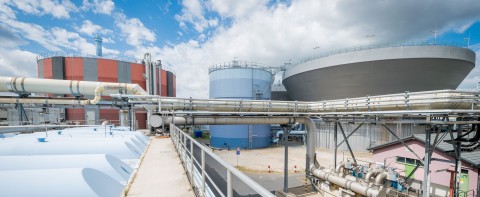Concrete: Built for a small eternity.
But only if properly maintained.
Reinforced concrete – it’s the ultimate “does everything and lasts forever” material. Its extraordinary load-bearing capacity can be easily appreciated by standing under a highway overpass. However, reinforced concrete can also deteriorate – as numerous crumbling bridges will attest.
Still, modern construction would be simply unimaginable without reinforced concrete serving as a load-bearing and design element. Along with steel construction, reinforced concrete really shines in the manufacturing industry: It gives operators the most freedom to maximize their use of the available space. But as with all infrastructure, the material requires regular inspections to stay durable and serviceable. At Industriepark Höchst, concrete structures are maintained by the team led by Jörg Schlicht, a master concrete mason: His specialists regularly inspect all the reinforced concrete structures at the park. They then make recommendations based on their findings and plan the necessary maintenance, which can include new construction.
No two structures are the same. To get the best possible economic outcome for our customers, we have to carefully analyze the existing structure, consider the customer’s preferences and then develop a resilient maintenance plan. Construction is teamwork!
Jörg Schlicht, Infraserv Höchst / Facilities Services, Master Concrete Mason
Reinforced concrete structures are constantly exposed to airborne corrodents such as moisture and carbon dioxide. Not to mention the chemical and mechanical stresses. Note that there is a difference between reinforcement corrosion and concrete corrosion. However, the chemical industry has its own special damage mechanisms that take their toll. They inflict damage more quickly and deeply than in other environments.
A prime example: Industriepark Höchst’s wastewater treatment plants with all their clarifiers. Interestingly, wastewater does not do the most damage to the fabric of the clarifier tanks. Instead, it’s the wastewater vapors that aggressively attack the reinforced concrete structure above the high-water mark. It’s tempting to think the sole culprit is biogenic sulfuric acid, which also occurs in municipal sewage treatment plants. However, structural wear is also promoted by other aggressive substances, whether planned or unplanned. Luckily, this type of damage only began fairly recently. This is partly because wastewater composition has changed significantly in recent years. And partly because vapors used to dissipate freely into the air – until the 1990s. At that time, covers were placed on the clarifiers to protect local residents from the odors. A gas zone now forms under the clarifier covers and exposes the concrete to elevated concentrations of pollutants.
Continuous monitoring is used at Industriepark Höchst. Our experts regularly inspect individual structures in the wastewater treatment plant during maintenance periods or shutdowns. We have even developed our own maintenance plan for this purpose. It allows us to plan maintenance economically in line with operational needs. One method of inspecting the condition of a plant is non-destructive testing such as a rebound hammer test. However, destructive testing methods cannot be avoided in some circumstances. They involve taking drill cores measuring 50 to 100 mm in diameter and examining them in the laboratory. The cores generally reach past the concrete cover. This can pose a challenge with clarifiers made of prestressed concrete: Care must be taken to avoid damage to the prestressed reinforcement elements (tendons).
The components of our wastewater treatment plant get damaged in a fundamentally different way than other reinforced concrete structures: Other structures often suffer from clearly visible carbonation damage. However, our plants commonly experience chloride damage. Sometimes, the damage may not be visible to the naked eye or appear similar to exposed aggregate concrete that has been mechanically abraded. However, this damage pattern could indicate that the reinforcement inside the concrete is completely corroded.
The rehabilitation work is as wide-ranging as the structures themselves. Depending on the type of damage, concrete rehabilitation methods can range from applying special surface protection systems to replacing the damaged concrete with special polymer-modified repair concrete and concrete replacement systems. Steel reinforcement can be damaged in a variety of ways, too. It, too, can be replaced or supplemented using many different approaches. Severely damaged reinforcement is completely removed and replaced with new steel bonded into the concrete using methods approved by the building authorities.
Our expert planners are specially certified to professionally draft the requisite tenders and monitor the work. The planning team always includes specialist engineers and, if the structures are severely damaged, structural engineers. Almost every conceivable repair method is needed to fix the damage that occurs at Industriepark Höchst: If we know what exposure classes or environmental influences to expect, we also know what repair approach to use during rehabilitation.
But our expertise goes far beyond wastewater plants. Other industrial structures made from reinforced concrete have to meet special requirements throughout their service lives, too. They range from office and administration buildings to warehouses and cooling towers. The cooling towers pose special challenges since their interiors contain fans used for generate vapor turbulence. The fans create dynamic loads and vibrations – in a constantly humid and windy environment, much like an internal monsoon. This obviously poses very different challenges from conventional buildings.
Challenges that should be familiar to every operator of this kind of industrial equipment. Along with the staffing difficulties that accompany them.


